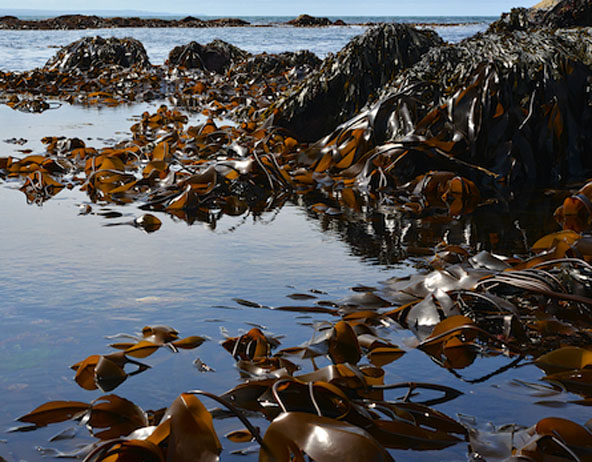
Common name
Oarweed, Kombu
Description
Laminaria digitata is a tough, leathery, dark brown seaweed that grows to two or three meters. The holdfast which anchors it to the rock is conical and has a number of spreading root-like protrusions called rhizoids. The stipe or stalk is flexible and oval in cross section. The blade is large and shaped like the palm of a hand with a number of more or less regular finger-like segments. This seaweed can be distinguished from the rather similar Laminaria hyperborea by being darker in color and having a shorter stipe that does not easily snap when bent.
Distribution
Laminaria digitata occurs in the north west Atlantic from Greenland south to Cape Cod and in the north east Atlantic from northern Russian and Iceland south to France. It is common round the coasts of the British Isles except for much of the east coast of England.
Ecology
Laminaria digitata is found mostly on exposed sites on shores in the lower littoral where it may form extensive meadows and can be the dominant algal species. It has a fairly high intrinsic growth rate compared to other algae, 5.5% per day, and a carrying capacity of about 40 kg wet weight per square meter. It may reach lengths of about 4 m. It overlaps to a small degree in distribution with Fucus serratus and Alaria esculenta. It is highly susceptible to grazing by sea urchins, among other species. It has low and high light limitation values of about 5 and 70 W per square meter respectively. Its distribution is also limited by salinity, wave exposure, temperature, desiccation and general stress.
Uses/ Benefits
Laminaria digitata was traditionally used as a fertilizer and spread on the land. In the 18th century it was burnt to extract the potash it contained for use in the glass industry. In the 19th century it was used for the extraction of iodine. Both these uses died out when cheaper sources for these products became available. It is still used as an organic fertilizer but also for the extraction of alginic acid, the manufacture of toothpastes and cosmetics, and in the food industry for binding, thickening and molding. It is used in Japan and China for making dashi, a soup stock, and for other culinary purposes.
Historically, the dried stalks of Laminaria digitata, called sea-tangle tents were used as an abortifacient and for inducing labor.
Nutritional Content of Laminaria Digitata
|
Nutrient |
Amount |
Unit |
Ref. |
|
Protein |
8-15 |
% dry weight |
(1) |
|
Ash |
38 |
% dry weight |
(1) |
|
Dietary fiber |
36-37 |
% dry weight |
(1) |
|
Carbohydrate |
48 |
% dry weight |
(1) |
|
Lipid |
1.0 |
% dry weight |
(1) |
|
Na |
3818 |
mg/100g dry weight |
(1) |
|
K |
11.5-79 |
mg/100g dry weight |
(1) |
|
Ca |
1005 |
mg/100g dry weight |
(1) |
|
Mg |
659 |
mg/100g dry weight |
(1) |
|
Fe |
3.2-9 |
mg/100g dry weight |
(1) |
|
Zn |
1.7 |
mg/100g dry weight |
(1) |
|
Mn |
<0.5 |
mg/100g dry weight |
(1) |
|
Cu |
<0.5 |
mg/100g dry weight |
(1) |
|
Iodine |
0.25-1.20 |
% dry weight |
(2) |
|
Vitamin B1 |
1.25 |
mg/100g dry weight |
(1) |
|
Vitamin B2 |
0.138 |
mg/100g dry weight |
(1) |
|
Vitamin B3 |
61.2 |
mg/100g dry weight |
(1) |
|
Vitamin B6 |
6.41 |
mg/100g dry weight |
(1) |
|
Biotin |
6.41 |
mg/100g dry weight |
(1) |
|
Cobalamin |
0.0005 |
mg/100g dry weight |
(1) |
|
Vitamin C |
35.5 |
mg/100g dry weight |
(1) |
|
Vitamin E |
3-3.4 |
mg/100g dry weight |
(1) |
Sources and References:
https://en.wikipedia.org/wiki/Laminaria_digitata
(1) Pereira L., A review of the nutrient composition of selected edible seaweeds; in: Seaweed
(2) Gall at al, A survey of iodine content in Laminaria digitata